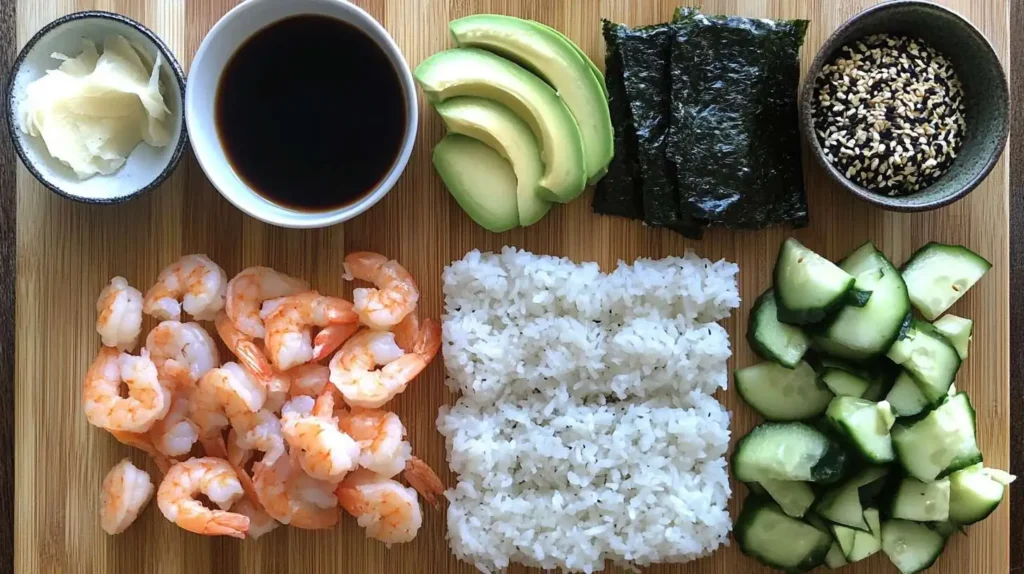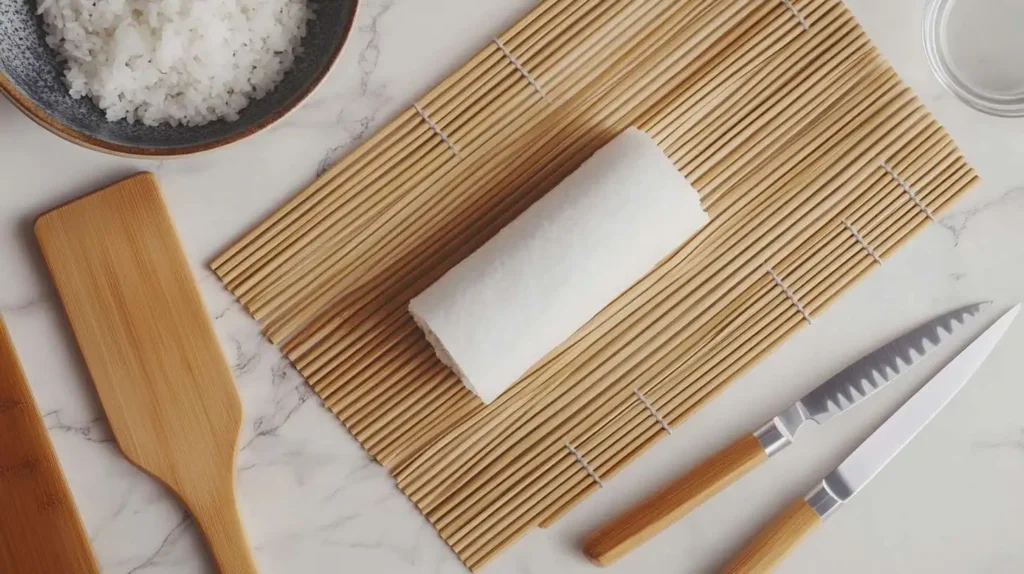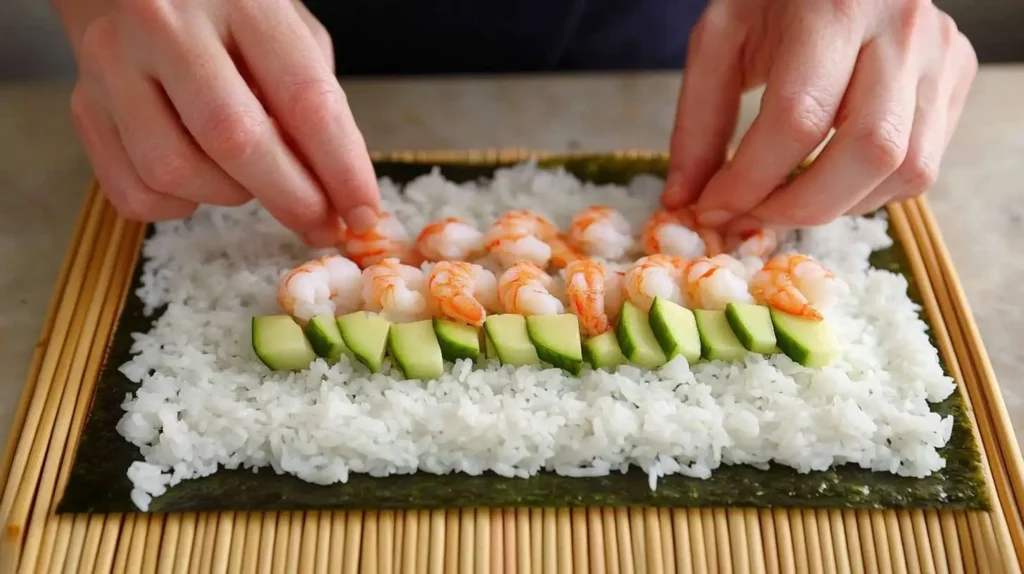Sushi is more than just food—it’s an experience. The perfect bite combines freshness, texture, and balance, making each roll unique. Among the many varieties, the Boston Roll stands out for its light, refreshing taste and approachable ingredients. Unlike traditional sushi featuring raw fish, this roll uses tender shrimp, creamy avocado, and crisp cucumber, all wrapped in sushi rice and nori, then topped with vibrant tobiko for a burst of flavor.
But what makes the Boston Roll truly special? How does it compare to other sushi rolls, and can it be made at home with the same quality found in top sushi restaurants? This guide will explore everything from its ingredients and variations to expert techniques for rolling it perfectly. Whether sushi is already a favorite or a new culinary adventure, the Boston Roll is one that deserves a place on the plate.
Table of contents
Key Ingredients in a Boston Roll
A perfect Boston Roll is built on a balance of flavors and textures, with each ingredient playing a crucial role in its taste and presentation. Unlike sushi rolls that feature raw fish, the Boston Roll is known for its use of cooked shrimp, making it a great choice for those who prefer a milder seafood experience. Here’s a closer look at the essential ingredients that bring this roll to life.
1. Shrimp (Ebi)
The star ingredient of the Boston Roll is shrimp, specifically poached or steamed to enhance its naturally sweet and delicate flavor. The shrimp is often butterflied and carefully prepared to achieve a smooth texture and an elegant appearance. Its mild taste pairs beautifully with the other ingredients, creating a well-rounded sushi roll.
2. Sushi Rice (Shari)
At the heart of any sushi roll is perfectly seasoned sushi rice. Short-grain Japanese rice is used, as its sticky texture allows the roll to hold its shape. The rice is seasoned with a blend of rice vinegar, sugar, and salt, giving it a subtle tang that complements the sweetness of the shrimp. Properly cooked and cooled sushi rice ensures the right consistency for rolling.
3. Nori (Seaweed)
A thin sheet of nori (dried seaweed) is used to wrap the sushi roll, holding the ingredients together. Nori adds a slightly salty, umami-rich flavor and provides structural integrity. For a Boston Roll, the rice is typically placed on the outside of the roll (uramaki style), with the nori hidden beneath the layers of rice.
4. Avocado
Creamy and rich, avocado adds a smooth texture that balances the slight chewiness of the shrimp and the crispness of the cucumber. It also enhances the roll’s mild and buttery flavor, making each bite more satisfying.
5. Cucumber
Cucumber contributes a refreshing crunch, bringing contrast to the soft textures of the shrimp and avocado. Its clean, watery taste helps balance the richness of the other ingredients, making the roll feel light and fresh.
6. Tobiko (Flying Fish Roe)
Tobiko, the small, vibrant orange fish roe, is often sprinkled on the outer layer of the roll. It adds a delicate crunch and a slight salty pop of flavor with every bite. The bright color also makes the roll visually appealing, adding to its signature look.
7. Optional Ingredients
Some variations of the Boston Roll may include additional ingredients for extra flavor. These can include:
- Sesame seeds – Sprinkled on the rice for a nutty aroma and added texture.
- Spicy mayo – Drizzled on top for a creamy, mildly spicy kick.
- Eel sauce – A sweet and savory glaze that enhances the overall taste.
Each ingredient in a Boston Roll is carefully chosen to create a balanced, flavorful, and visually stunning sushi roll. Understanding these key elements is the first step in appreciating or even making this delicious roll at home.
How to Make a Boston Roll at Home
Making sushi at home may seem intimidating, but with the right ingredients and technique, a perfect Boston Roll can be created in any kitchen. This step-by-step guide will walk through the process, from preparing the rice to rolling and cutting the sushi like a pro.
1. Gather the Ingredients and Tools

Essential Ingredients:
- 2 cups cooked sushi rice
- 2 tablespoons rice vinegar
- 1 teaspoon sugar
- ½ teaspoon salt
- 4 sheets of nori (seaweed)
- 12 cooked shrimp (butterflied)
- 1 avocado (sliced)
- 1 cucumber (julienned)
- ¼ cup tobiko (flying fish roe)
- Optional: sesame seeds, spicy mayo, eel sauce
Tools Needed:

- Bamboo sushi mat (makisu)
- Plastic wrap
- Sharp knife
- Rice paddle or wooden spoon
- Small bowl of water (to prevent sticking)
2. Prepare the Sushi Rice
Sushi rice is the foundation of a great roll. To achieve the perfect texture:

- Rinse the sushi rice under cold water until the water runs clear.
- Cook the rice according to the package instructions or using a rice cooker.
- In a small bowl, mix rice vinegar, sugar, and salt, then gently fold it into the cooked rice while it’s still warm.
- Allow the rice to cool to room temperature before assembling the roll.
3. Prepare the Shrimp and Vegetables
- The shrimp should be cooked, butterflied, and patted dry before use.
- Slice the avocado into thin strips.
- Cut the cucumber into long, thin julienne slices.

4. Assemble the Boston Roll
- Wrap the bamboo mat: Cover the sushi mat with plastic wrap to prevent the rice from sticking.
- Prepare the nori: Place a sheet of nori on the plastic-covered sushi mat, shiny side down.
- Spread the rice: Wet your hands with water to prevent sticking, then evenly spread a thin layer of sushi rice over the nori.
- Add tobiko (optional): Lightly sprinkle tobiko on top of the rice for extra color and flavor.
- Flip the nori over: Carefully turn the nori and rice over so the rice is on the outside.
- Layer the fillings: Place the shrimp, avocado, and cucumber in a straight line across the center of the nori.
5. Roll the Sushi
- Start rolling from the edge closest to you, using the bamboo mat to gently lift and tuck the ingredients.
- Apply light pressure to form a tight roll, continuing until the seam is sealed.
- Press lightly to ensure the roll holds its shape.
6. Slice and Serve the Boston Roll
- Using a sharp knife, wet the blade with water to prevent sticking.
- Cut the roll in half, then slice each half into three even pieces for a total of six sushi pieces.
- Garnish with more tobiko, sesame seeds, or a drizzle of spicy mayo for extra flavor.
7. Enjoy Your Homemade Boston Roll
Serve with soy sauce, pickled ginger, and wasabi for an authentic sushi experience. With practice, making Boston Rolls at home can become an enjoyable and rewarding culinary skill.
Tips for Perfect Sushi Rice
Sushi rice is the foundation of any great roll, and getting it right is key to making a Boston Roll that holds together well and tastes authentic. The texture should be slightly sticky but not mushy, with a delicate balance of sweetness and acidity. Here are some expert tips to ensure perfect sushi rice every time.
1. Choose the Right Rice
- Always use short-grain or medium-grain Japanese rice, such as sushi rice or Calrose rice. These varieties have the right amount of starch to create the necessary stickiness.
- Avoid long-grain rice, as it lacks the required texture and will not hold together properly.
2. Rinse the Rice Properly
- Rinse the rice under cold water until the water runs clear. This removes excess starch that can make the rice too sticky or gummy.
- Let the rice drain in a fine-mesh sieve for at least 15 minutes before cooking.
3. Cook the Rice Correctly
- Use a 1:1.2 ratio of rice to water for the best texture. If using a rice cooker, follow the manufacturer’s instructions.
- If cooking on the stovetop, bring the water to a boil, then cover and simmer on low for 15 minutes before letting it rest for another 10 minutes off the heat.
4. Season the Rice Properly
- Sushi rice gets its signature flavor from a mixture of rice vinegar, sugar, and salt. The standard ratio per 2 cups of rice is:
- 2 tablespoons rice vinegar
- 1 tablespoon sugar
- ½ teaspoon salt
- Heat the mixture until the sugar dissolves, then gently fold it into the cooked rice with a wooden spatula.
5. Cool the Rice Correctly
- Spread the rice in a wide, shallow bowl to cool. Avoid stirring too much, as this can damage the grains.
- Use a fan or gentle breeze to cool the rice quickly while giving it a glossy texture.
By following these steps, the sushi rice will have the perfect balance of stickiness, flavor, and texture, making it ideal for rolling a Boston Roll.
Common Mistakes When Making a Boston Roll
Even with the right ingredients and techniques, a few mistakes can ruin the texture, taste, or appearance of a Boston Roll. Here are some common errors and how to avoid them.
1. Overpacking the Roll
- Adding too much rice or too many fillings can make the roll difficult to close, leading to messy or loose sushi.
- Solution: Use a thin layer of rice and moderate amounts of shrimp, avocado, and cucumber for a well-balanced roll.
2. Using Too Much or Too Little Rice Vinegar
- Over-seasoned rice can become too tangy, while under-seasoned rice will taste bland.
- Solution: Stick to the recommended rice vinegar ratio and mix it evenly into the rice.
3. Rolling Too Tightly or Too Loosely
- Rolling too tightly can crush the ingredients, while rolling too loosely can cause the roll to fall apart.
- Solution: Apply gentle, even pressure when rolling and use a bamboo mat to shape it properly.
4. Cutting the Roll Incorrectly
- A dull knife can crush the roll, and cutting without cleaning the knife can cause the rice to stick.
- Solution: Use a very sharp knife and wet the blade between slices to ensure clean cuts.
5. Not Keeping Hands and Tools Moist
- Dry hands can cause rice to stick, making it difficult to spread evenly on the nori.
- Solution: Keep a small bowl of water nearby to moisten hands and prevent sticking.
Avoiding these mistakes will ensure a perfectly rolled, delicious Boston Roll every time.
Conclusion
The Boston Roll is a delicious and approachable sushi roll that brings together tender shrimp, creamy avocado, crisp cucumber, and perfectly seasoned sushi rice. Its balance of textures and mild seafood flavor makes it an excellent choice for both sushi beginners and seasoned sushi lovers. Whether enjoyed at a sushi restaurant or made at home, this roll delivers a fresh and satisfying taste in every bite.
By following the right techniques—using high-quality sushi rice, rolling carefully, and cutting with precision—homemade Boston Rolls can rival those found in the best sushi bars. With a little practice, anyone can master this roll and experiment with creative variations. Whether served as part of a sushi platter or enjoyed on its own, the Boston Roll is a must-try for anyone who appreciates fresh, flavorful sushi.
Recipe Articles You Might Like
For those who enjoy seafood flavors beyond sushi, learning how to keep shrimp moist while grilling can enhance other shrimp-based dishes, including those that complement a sushi night. If you’re looking to expand your sushi skills, a rich and creamy garlic Parmesan sauce can be a fantastic dip for tempura-fried sushi rolls. Additionally, for those who appreciate traditional sushi, our Nigiri Sushi Recipe offers a refined take on hand-formed sushi that highlights the fresh, delicate flavors of premium seafood.
Last but not least, for those who love the balance of textures in a Boston Roll, you might also enjoy experimenting with a Philly Chicken Cheesesteak, which offers a different but equally satisfying combination of creaminess, crunch, and savory goodness.
Frequently Asked Questions (FAQs)
What is a Boston Roll made of?
A Boston Roll consists of cooked shrimp (ebi), avocado, and cucumber wrapped in sushi rice and nori (seaweed). It is often topped with tobiko (flying fish roe) for added texture and a slight burst of salty flavor. The roll is made uramaki-style, meaning the rice is on the outside.
Does a Boston Roll have cream cheese?
No, a traditional Boston Roll does not contain cream cheese. However, some sushi chefs create variations that include cream cheese for added richness, but this is not part of the authentic recipe.
What is the difference between a Boston Roll and a New York Roll?
The main difference lies in the protein used. A Boston Roll features cooked shrimp, while a New York Roll typically includes smoked salmon. Both rolls share similar ingredients, such as avocado and cucumber, but their flavor profiles differ due to the choice of seafood.
Is the Boston Roll good?
Yes, the Boston Roll is a popular choice among sushi lovers, especially for those who prefer cooked seafood over raw fish. It has a fresh and slightly sweet taste, a creamy texture from the avocado, and a crisp bite from the cucumber. The addition of tobiko enhances the experience with a subtle crunch and salty umami flavor.

